Comparative analysis and modelling of air quality situations in a sample of world cities. Comparison with the Medellin case
DOI:
https://doi.org/10.33571/rpolitec.v13n25a1Keywords:
Air quality, Criteria pollutants, Air Quality Indicators, cities, analysis, correlations, comparisons, strategy, Medellín, parameters, environmental variablesAbstract
For a sample of 25 cities from different countries, information was collected on the annual air quality for PM2.5, NO2 and ozone and also on various parameters of interest as to their potential relation with air quality. A comparative analysis of this information and a linear model that relates the air quality to some of the parameters was elaborated, based on the level of approximation found between the air qualities reported and those predicted by the modeling. The data are based on reports and information available on websites and public reports and also on research reports done by the authors for the years 2012 and 2015. With this comparative analysis it has been possible to present a novel perspective on the air quality situation of the city and on the type of strategic measures that could be taken to improve the air quality situationArticle Metrics
Abstract: 2210 HTML (Español (España)): 192 PDF (Español (España)): 1339 XML (Español (España)): 57PlumX metrics
References
Green, J. Sánchez, S. La Calidad del Aire en América Latina: Una Visión Panorámica, Clean Air Institute, 2013.
WHO’s Urban Ambient Air Pollution database‐ Update 2016.
United States Environmental Protection Agency. Air Data: Air Quality Data Collected at Outdoor Monitors across the US. Disponible en: https://www.epa.gov/outdoor-air-quality-data [Consultado el 20 de noviembre de 2016]
Dirección general de sostenibilidad y planificación de la movilidad. La Calidad del Aire, Madrid 2014.
European Environment Agency, Air pollution fact sheet 2014, Netherlands, 2014.
INFORME DE CALIDAD DE AIRE, Informe anual Servicio Evaluación de la Calidad y Control Ambiental, Departamento de Desarrollo Ambiental Intendencia de Montevideo, s.f., 2013
Mo Dana, Guoshun Zhuanga, B, Xinxin Lia, Hairong Taoa, Yahui Zhuangc. The characteristics of carbonaceous species and their sourcesin PM2.5 in Beijing. The Center for Atmospheric Environmental Study, Beijing Normal University, Beijing 100875, PR China.2013.
Posada, E. Gómez, M. Cadavid, A. THE IMPORTANCE OF MOTOR VEHICLE EMISSIONS ON THE PM2.5 POLLUTION OF THE CITY OF MEDELLÍN AS DEDUCTED FROM THE HOURLY VARIATIONS IN PM2.5 CONCENTRATIONS AND FROM CHEMICAL ANALYSIS OF PM2.5 MATERIAL. Presented at Air Quality 2016, Milán, Italia, marzo de 2016.
Gebhart, Kristi A. Malm, William C. Flores M. A Preliminary Look at Source-Receptor Relationships in the Texas-Mexico Border Area. Journal of the Air & Waste Management Association, 50,858-868, 2000.
Resolución 610, Ministerio de Ambiente, Vivienda y Desarrollo Territorial. República de Colombia, 2010
Informe Final de Calidad del Aire en el Valle de Aburra, Convenio de Asociación No. 243 de 2012. Área Metropolitana del Valle de Aburra, 2013.
Área Metropolitana del Valle de Aburra. Estudios de calidad del aire. Disponible en:http://www.metropol.gov.co/CalidadAire/Paginas/bibliotecaaire3.aspx [Consultado el 20 de noviembre de 2016]
PERRY J. SAMSON, Dispersión Atmospheric Transport and Dispersion of Air Pollutants Associated with Vehicular Emissions. University of Michigan. En: Air Pollution, the Automobile, and Public Health. Watson AY, Bates RR, Kennedy D, editors., Washington (DC): National Academies Press (US); 1988.
J.L. Jaimes-López et al. EXPERIMENTAL STUDY OF OZONE-FORMING POTENTIAL FROM EXHAUST EMISSIONS OF VEHICLES FUELED WITH REFORMULATED GASOLINE IN MÉXICO CITY. Rev. Int. Contam. Ambient. 22 (4) 165-172, 2006
Greenpeace. Greenpeace: China saw average PM2.5 levels fall by 10% in 2015, but 80% of cities still fail to meet National Air Quality Standards. Disponible en: http://www.greenpeace.org/eastasia/press/releases/climate-energy/2016/Q4-City-Rankings-2015/ [Consultado el 20 de noviembre de 2016]
WHO. Review of evidence on health aspects of air pollution – REVIHAAP, WHO Regional Office for Europe, 2013
Posada E (2017) Considerations of the Impact of PM2.5 Particulate Matter a Health: The Meaning and Impact of Levels and Air Quality Limits on the Aburrá Valle Region in Colombia. J Environ Anal Toxicol 7: 467. doi: 10.4172/2161-0525.1000467
Smart cities may help combat air quality issues, scientists say. Published Times of India, Apr 20, 2016 in http://timesofindia.indiatimes.com/home/science.


 _
_






















